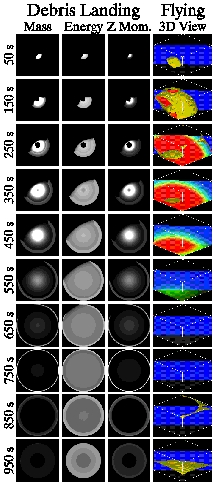Physics of the Shoemaker-Levy 9 Impacts
Dr. Joseph Harrington (Cornell)
With almost every major telescope and available spacecraft
participating, the Shoemaker-Levy 9 impacts onto Jupiter were the
most-observed events in the history of professional astronomy. Yet,
there remain many more questions than answers surrounding the
voluminous observations: Why were the debris patterns shaped as they
were? How could the impact-site temperature drop many times faster
than can be explained by thermal radiation? What caused the last of
the precursor flashes in the lightcurves, and how about the
post-impact flare or the oscillatory "bounces" observed at Palomar and
elsewhere? Why did a ring of heat expand at more than 1.5 times the
sound speed for hours after impact? Why did the lightcurves' shapes
depend so strongly on wavelength? Only about 20 theoretical papers
exist, all focussing on the early, data-scarce phases of the events.
Almost none connect to data in a meaningful way. We have divided the
impacts into phases based on the prevailing physics. Our new models
extend early-phase theory to times when good observations are
available, and create synthetic observables for detailed comparison to
the data. Our models now explain all features of the images and
lightcurves, introduce no new features, and reveal new insights into
the physics of large impacts.
This talk will be given at the Cornell
Astronomy Department Colloquium, 4:30 - 5:30 pm, Thursday 1 March
2000, in room 105 Space Sciences Building. Refreshments at 4:10.
 Last revised: 2000 Nov 22 - J. Harrington
Last revised: 2000 Nov 22 - J. Harrington

